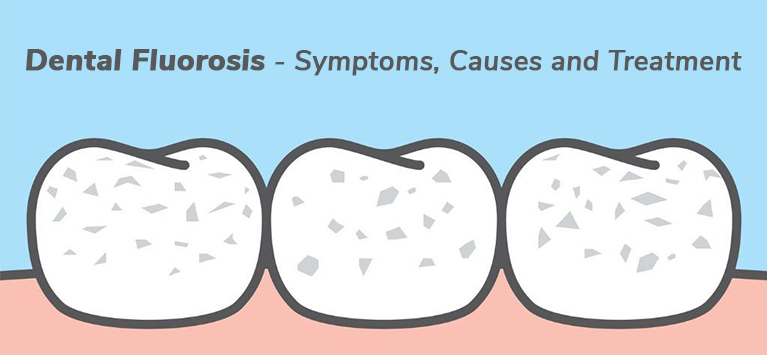
Dental Fluorosis – Symptoms, Causes, and Treatment
Fluoride is a must for healthy teeth; it enhances enamel mineralization and prevents decay. But overexposure can lead to dental fluorosis while teeth develop.
Dental fluorosis is a condition that attacks the enamel and must be taken into notice. White spots or discoloration on the teeth are the most visible sign of fluorosis.
In our childhood, we may have taken too much fluoride during the developing stage of our teeth. This affects our teeth’ appearance in multiple ways.
Dental Fluorosis Symptoms
Your teeth will have the following appearance
1) Chalky appearance
2) Cloudy white lines
3) A visible cavity in tooth enamel
4) Roughness
5) Brown or yellow discoloration
Dental fluorosis has no relation to poor oral hygiene. This is only because of too much intake of fluoride while our teeth are developing.
Causes of Fluorosis
Fluoride is a great mineral that strengthens tooth enamel naturally and safeguards our teeth from decay. Taking this fluoride in a required and limited quantity has benefit, but too much of intake has no benefit.
This fluoride is added to mouthwashes and toothpastes in certain approved concentrations. Due to its benefit, it is also added to drinking water and in many foods. But the causes are due to
-Drinking water that has excessive fluoride concentrations
-Eating foods that have higher fluoride levels
-Accidentally Swallowing mouthwashes or toothpaste that contains fluoride
-Taking additional fluoride supplements even after getting the required amount of fluoride.
Effects of Dental Fluorosis
People affected with severe or moderate dental fluorosis have the following effects
1) Teeth sensitivity
2) Tooth decay due to the weak enamel structure.
Note: Dental fluorosis is irreversible because it occurs during the developmental stage of teeth.
The time where the fluorosis develop
Children who are around age eight have a higher risk of getting affected by dental fluorosis. Their intake of fluoride decides the severity of dental fluorosis. White marks on a child’s teeth are an indication of fluorosis and should be diagnosed early.
Moreover, dental fluorosis does not occur suddenly for an adult. If you find white spots suddenly, especially if you are an adult, it is due to decalcification or some other dental problems which can be diagnosed by a dentist.
Also, dental fluorosis should be monitored and treated early in childhood before it gets worse in adulthood.
Types of dental fluorosis
Dental fluorosis is divided into mild, moderate, and severe based on its intake.
Mild Fluorosis
Cloudy or pearly white borders, marks, or patches on the tooth enamel surface. This is slight and can be corrected by a dentist.
Moderate fluorosis
Chalky appearance, where the white spots cover more areas of the tooth. It spoils our aesthetic appearance but does not cause any pain.
Severe fluorosis
This is the worst condition where brown or yellow spots appear additionally to chalky appearance. Here the enamel becomes rough, pitted or brittle.
Dental fluorosis treatment
There are some options that help you to give good aesthetic appearance if affected by dental fluorosis. They are:
1) Teeth whitening
2) Polishing or microabrasion
3) Veneers
4) Dental bonding
Prevention
1) Check fluoride in your water supply.
2) Do not take give fluoride supplements to your child without any instruction.
3) Say your children not to swallow toothpaste.
4) Check your fluoride intake if you are pregnant.
5) Do not give fluoride mouthwash to a child until age 6.
It’s time to save your child’s tooth. Don’t completely stop giving the usage of fluoride to them. Give them in a required amount and visit your dentist if you find any indication of fluorosis.










